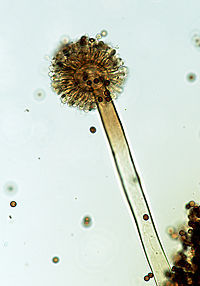Aspergillus niger
For the course duration, the article is closed to outside editing. Of course you can always leave comments on the discussion page. The anticipated date of course completion is May 21, 2009. One month after that date at the latest, this notice shall be removed. Besides, many other Citizendium articles welcome your collaboration! |
| Aspergillus niger | ||||||||||||||||||||||
|---|---|---|---|---|---|---|---|---|---|---|---|---|---|---|---|---|---|---|---|---|---|---|
 | ||||||||||||||||||||||
| Scientific classification | ||||||||||||||||||||||
| ||||||||||||||||||||||
| Binomial name | ||||||||||||||||||||||
| Aspergillus niger |
Description and significance
Aspergillus niger is a filamentous fungus; it is an eukaryotic organism that belongs to the Fungi kingdom and is part of the microbial communities found in soil. There are many different species from the [[Aspergillus] genus that exist. A. niger is said to be one of the most common species; that is omnipresent in soil and exists in indoor environments. The presence of A. niger causes plants, fruits and vegetables to grow black mold. It can be classified as a member of the microbial communities that are found in soils and normally, A. niger is haploid but is capable of growing into a heterokaryon or take on as in diploid form. The species has is many nucleates where as the conidia have only one nucleus, also known as mononucleate and as completes the development cycle it may form different cell types.
The significance of A. niger is the role that it plays in the industries for production of enzymes and metabolites, i.e. citric acid. Citric acid serves its purpose to the food industry by improving the taste, nutrition and shelf-life of food products. This industrial fungus also has the capability to act as a host to produce heterologous proteins. There have been many studies conducted with A. niger, such as cell wall [biosynthesis], fungal protein [secretion], proteolysis, cell morphology and polarity and degradation of plant (cell wall) polysaccharides, just to name a few. It is a key organism that carries on the production of proteins, mostly enzymes and is of great importance in biotechnology for industrial enzymes, in the food industry and pharmaceuticals.
Genome structure
The genome sequencing of Aspergillus niger can be performed with many advanced biological analysis techniques that aid in the production processes. With more research on A. niger, there are more possibilities for use of this microbe that could be beneficial; as there are 7,500 genes that are still not yet known.
In November 2005, the JGI previously released an Aspergillus niger strain ATCC 1015 genome sequence; the strain serves a duty in the industrial production of citric acid. The A.niger strain CBS 513.88 genome was sequenced as an project by 29 international groups and the results were published in February 2007 issue of Nature Biotechnology by DSM. To sequence the genome of A. niger CBS 513.88, the team used a process called BAC walking, which required the use of an ordered set of large E. coli bacterial artificial chromosomes (BACs). Results indicated that the size of the genome of A. niger CBS 513.88 was a 33.9-megabased genome and has a total of 14, 165 genes. The assembled genome sequence consists of 468 DNA contigs that span a total of 33.9 million base pairs that are unique. A. niger strain CBS 513.88 is the early ancestor of the ATCC 1015 strain.
Cell structure and metabolism
A. niger is a fungus, but it is specified as a mold. Therefore, A. niger takes on many of the common features that a microscopic fungi which grows in a filamentous form that are multicellular and called hyphae. Those microscopic fungi that are not multicellular, but are single celled fungi are known as yeasts. These hyphae that appear as an connected network that are tube-shaped, branched contain nuclei that are identical genetically nuclei, can be considered as a single organism, which are called a colony or a mycelium.
Ecology
Pathology
Application to Biotechnology
Current Research
References
Vijayanandraj, V.R., Nagendra Prasad, D., Mohan, N., Gunasekaran, M. "Effect of Ozone on Aspergillus niger Causing Black Rot Disease in Onion". Ozone: Science & Enginerring. October, 2006. Vol. 28, Issue 5. p.347-350.